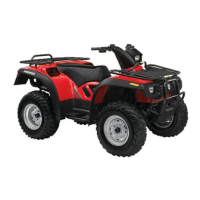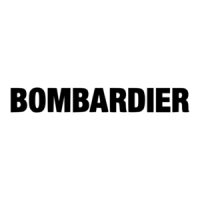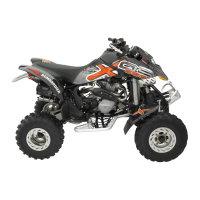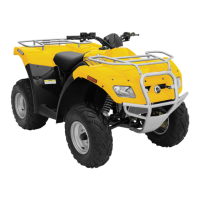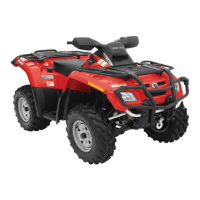Tires/Wheels
WARNING
When the tires are replaced, never
install a bias tire with a radial tire.
Such a combination could create
handling and/or stability prob-
lems.
Donotmixtiresofdifferentsize
and/or design on the same axle.
Front and rear tire pairs must be
the identical model and manufac-
turer.
For unidirectional tread pattern,
ensure that the tires are installed
in the correct direction of rotation.
The radial tires must be installed
as a complete set.
Severe injury or death can result
if you do not follow these instruc-
tions.
Tire Pressure
WARNING
Tire pressure greatly affects vehi-
cle handling and stability. Under-
pressure may cause tire to deflate
and rotate on wheel. Overpres-
suremayburstthetire. Always
follow recommended pressure.
Since tires are low-pressure types,
a manual pump should be used.
Check pressure when tires are “cold”
before using the vehicle. Tire pres-
sure changes with temperature and
altitude. Recheck pressure if one of
these conditions has changed.
For your convenience, a pressure
gauge is supplied in tool box.
TIRE PRESSURE
ALL MODELS
FRONT REAR
MAX.
48 kPa
(7 PSI)
48 kPa
(7 PSI)
up to
290 kg
(640 lb)
MIN.
35 kPa
(5 PSI)
35 kPa
(5 PSI)
Although the tires are specifically de-
signed for off-road use, a flat may still
occur. Therefore, it is recommended
to carry a tire pump and a repair kit.
Tire/Wheel Condition
Check tire for damage and wear. Re-
place if necessary.
Do not make a tire rotation. The front
and rear tires have a different size.
The tires are directional and their ro-
tation must be kept in a specific direc-
tion for proper operation.
Wheel Removal
Loosen nuts then lift vehicle. Place a
support under vehicle. Remove nuts
then remove wheel.
At installation, it is recommended to
apply antiseize lubricant on threads.
Gently tighten nuts in a criss-cross se-
quence then apply a final torque of
75 N•m(55lbf•ft).
140
_____________________
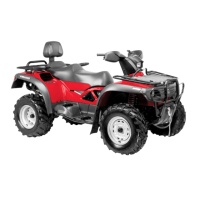
